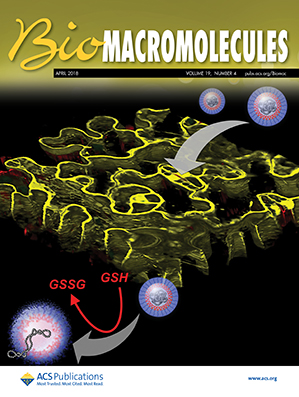Dual-Cross-linked Methylacrylated Collagen-DPPA Bioinks for Precision DLP Bioprinting and Accelerated Skin Wound Healing
IF 5.4
2区 化学
Q1 BIOCHEMISTRY & MOLECULAR BIOLOGY
引用次数: 0
Abstract
Digital light processing (DLP) bioprinting, known for its speed and precision, has become a key tool in disease modeling and regenerative medicine. Yet, creating bioinks with optimal printability, bioactivity, and cell-supporting capacity remains a major challenge. Here, we introduce a novel dual-network collagen-based bioink, methyl acrylated collagen-dimethylphenylphosphonate (CMA-DPPA), which enables the fabrication of mechanically robust and highly printable cell-laden constructs through DLP 3D bioprinting. The CMA-DPPA hydrogel is synthesized by cross-linking collagen with DPPA, followed by photo-crosslinking with CMA; this dual-cross-linking approach markedly improves printing fidelity, mechanical strength, and enzymatic degradation resistance of the 3D-printed constructs. The CMA-DPPA hydrogel exhibits excellent biocompatibility, effectively promoting cell adhesion, proliferation, and migration. In a rat model of full-thickness skin defects, CMA-DPPA hydrogel facilitated organized collagen fiber deposition and accelerated epidermal regeneration, thereby expediting wound closure. CMA-DPPA bioink enables precise, robust scaffold fabrication, showing great promise for DLP-based tissue engineering and regenerative medicine.
- Download: Download high-res image (268KB)
- Download: Download full-size image
用于精确DLP生物打印和加速皮肤伤口愈合的双交联甲基丙烯酸基胶原蛋白- dppa生物墨水。
数字光处理(DLP)生物打印以其速度和精度而闻名,已成为疾病建模和再生医学的关键工具。然而,创造具有最佳可打印性、生物活性和细胞支持能力的生物墨水仍然是一个主要挑战。在这里,我们介绍了一种新型的双网络胶原基生物链接,甲基丙烯酸基胶原-二甲基苯基膦酸酯(CMA-DPPA),它可以通过DLP 3D生物打印制造机械坚固且高度可打印的细胞负载结构。将胶原蛋白与DPPA交联,再与CMA光交联,合成CMA-DPPA水凝胶;这种双交联方法显著提高了3d打印结构的打印保真度、机械强度和酶降解抗性。CMA-DPPA水凝胶具有良好的生物相容性,能有效促进细胞粘附、增殖和迁移。在大鼠全层皮肤缺损模型中,CMA-DPPA水凝胶促进有组织的胶原纤维沉积,加速表皮再生,从而加速伤口愈合。CMA-DPPA生物链接可以实现精确、坚固的支架制造,在基于dlp的组织工程和再生医学中显示出巨大的前景。
本文章由计算机程序翻译,如有差异,请以英文原文为准。
求助全文
约1分钟内获得全文
求助全文
来源期刊

Biomacromolecules
化学-高分子科学
CiteScore
10.60
自引率
4.80%
发文量
417
审稿时长
1.6 months
期刊介绍:
Biomacromolecules is a leading forum for the dissemination of cutting-edge research at the interface of polymer science and biology. Submissions to Biomacromolecules should contain strong elements of innovation in terms of macromolecular design, synthesis and characterization, or in the application of polymer materials to biology and medicine.
Topics covered by Biomacromolecules include, but are not exclusively limited to: sustainable polymers, polymers based on natural and renewable resources, degradable polymers, polymer conjugates, polymeric drugs, polymers in biocatalysis, biomacromolecular assembly, biomimetic polymers, polymer-biomineral hybrids, biomimetic-polymer processing, polymer recycling, bioactive polymer surfaces, original polymer design for biomedical applications such as immunotherapy, drug delivery, gene delivery, antimicrobial applications, diagnostic imaging and biosensing, polymers in tissue engineering and regenerative medicine, polymeric scaffolds and hydrogels for cell culture and delivery.
 求助内容:
求助内容: 应助结果提醒方式:
应助结果提醒方式:


